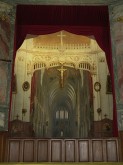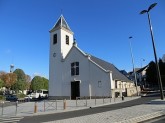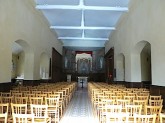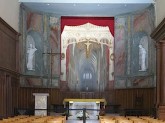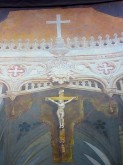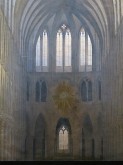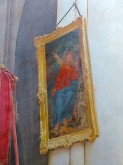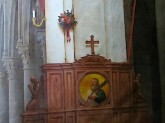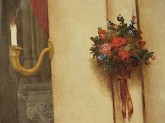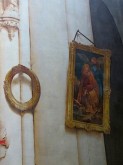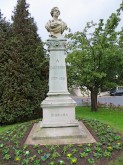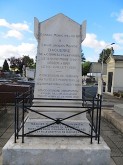The browser will either open the file, download it, or display a dialog.
Daguerre’s Sole Extant Diorama, Recently Restored
Daguerre’s Gothic Church Interior in Saint-Gervais-Saint-Protais de Bry
Bry-sur-Marne, France
Fall 2013
Louis-Jacques-Mandé Daguerre (1787–1851) is best known as the artist responsible for creating the first practical form of photography, the daguerreotype. Prior to the announcement of his new camera on August 19, 1839, however, he was an accomplished painter and developer of the diorama theater whose magnificent tableaux were highly popular in Paris in the 1820s and 1830s. His sole remaining diorama, which depicts an unnamed Gothic church interior, was recently restored and is now back on permanent view to the public after more than a century of neglect when it was hidden behind a curtain (fig. 1). I viewed the painting in Bry-sur-Marne, a small town about seven miles outside of Paris, in October 2013, while attending the 25th anniversary of the Daguerreian Society symposium. The diorama is a stunning example of Daguerre’s exquisite command of trompe l’oeil illusion, Christian iconography, and use of natural light. It is well worth a side trip to study his artistic achievements in person.
After the catastrophic fire at Daguerre’s Parisian diorama theater in 1830, which had been his only source of income, the artist moved to Bry-sur-Marne and purchased a vast property situated across the street from the church of Saint-Gervais-Saint Protais de Bry, built in the twelfth century and rebuilt in 1610 (fig. 2). Once the chaplain agreed to extend the building to accommodate the new work, Daguerre created a diorama specifically for the apse of this modest church, beginning his work in 1839. The large painting (about 5 1/2 x 6 meters or about 18 x 20 ft.; roughly 32 square meters) depicts the recessive depth of a Gothic cathedral in order to decorate and extend the perspective of the small, spare building (fig. 3). Behind the altar is a wooden stage flanked on either side by two life-size figurative sculptures in niches against a faux marble background (fig. 4). At the rear of the stage is the diorama framed by a red velvet curtain, which echoes similar drapery in the painting itself, leading into the cathedral’s long chancel. Above the stage is a skylight, which allows natural light to play across the surface of the canvas (fig. 5). Modulating natural light also enters from the sides, creating flickering effects caused by the movement and position of the sun and clouds. This spellbinding lighting transformed the scene to such an extent that a priest from Paris thought the work was blasphemous; and the congregation was known to cease praying as it watched the changing display. Church-goers could witness a veritable moving show during mass. Not surprisingly, people came from throughout the world to see the diorama.
Born in Cormeilles-en-Parisis, Val-D’Oise, Daguerre apprenticed in architecture, theater design, and panoramic painting with Pierre Prévost, the first French panoramic painter. His skill at theatrical illusion led to a career as a celebrated theater designer, and in the spring of 1821, he partnered with Charles Bouton, a more experienced painter, to create a diorama theater. They opened their theater in Paris in July 1822, showing two tableaux, one by each man. This became their pattern, with each painter producing either an interior or landscape. The artists painted translucent canvases, about 70 feet wide by 45 feet tall, on both sides with vivid, detailed pictures and lit them from different angles. As lights changed, the audience (about 350 people, standing) would begin to see the painting on the other side of the screen, and the effect was awe-inspiring. Daguerre and Bouton exhibited twenty-one paintings in the first eight years of their partnership. Many were of sacred spaces, such as Trinity Chapel in Canterbury Cathedral, Chartres Cathedral, Holyroodhouse Chapel, and Rosslyn Chapel, both in Edinburgh, and others were of exterior spaces such as the environs of Paris, the Valley of Sarnen, the harbor at Brest, and the city of Rouen. Eventually, Daguerre acquired sole responsibility for the theater.
In the Bry-sur-Marne diorama, one is struck by the painstaking detail, from the elaborate architectural decorations in the arch above the large crucifix hanging from the ceiling (fig. 6), which would be raised and lowered by the red cords affixed to it, to the convincing realism of the hazy space and minute depiction of windows at the rear of the chancel (fig. 7). Daguerre referred to pivotal moments in Christ’s life by including paintings of him in infancy, held by the Virgin Mary, and later carrying the cross. The latter gilt-framed image hangs on a column on the left side of the composition (fig. 8). On both sides of the entrance to the chancel in the foreground are altars featuring roundels of the saints for whom the church is named, St. Protais on the left and St. Gervais on the right (fig. 9). Above each wooden structure hangs a beribboned, fresh bouquet on the columns. On the same set of compound columns are gold sconces. The candle in the fixture on the right has just been extinguished; the wax drips and the wick glows, emitting a trace of smoke (fig. 10). This refers to the death of Christ, as does the empty oval picture frame hung above it (fig. 11). Two of the most compelling features of the breathtaking scene are tiny, almost incidental details that convincingly portray the realism of the architecture. These are a small metal hook in a chink between a column’s stone blocks and a cobweb in a vertical mortar join (fig. 12).
Around 1860, a priest whose back was to the painting while at the altar, felt too cold in the unheated church, and installed a curtain over the diorama which stayed in place until the early twentieth century. In 1905, with the separation of church and state in France, a new priest wanted to adapt the church and moved the interior tombs, including that of Etienne Silhouette (1709-1767), outside to the cemetery. In 1913 the diorama was classified as an historical monument, the first contemporary work designated as such, but it was still hidden behind the curtain. Around 1945–50, the town became concerned about deterioration of the piece, but no one remembered what a diorama was. Mediocre conservators split the painting down the middle, scratched the painting off the rear, and applied a thick canvas with wood glue to the back of the composition—but left it behind the curtain. In the 1980s the town wanted a better restoration job, but the French state brought in the same firm. This team found enormous folds in the wood and it discovered that the glue had soaked through the canvas. It used an office stapler to staple the work to a giant wooden frame, then covered it with brown wrapping paper and painted over that surface, and repainted several areas. The work was poorly done, and the diorama remained behind the curtain. In 1999, the town requested a new approach and the state produced a 140-page study. An exhibition about Daguerre followed in Bry-sur-Marne in 2001 and then the town realized that what it had was not merely a trompe l’oeil painting, but an actual diorama.
Bry-sur-Marne’s mayor, Jean-Pierre Spilbauer, recognized the significance of Daguerre’s work and, in 2006, raised funds for its restoration from the government and region. The Getty Foundation gave $200,000 to cover half the expenses, matched by the Ministry of Culture. Dominique Dollé and the city’s conservator, Margaret Calvarin, supervised the restoration of the diorama in a specially constructed workshop with ten additional conservators, first removing the dirt from the pictorial layer (made of three strips), the uneven and yellowed varnish, and the repainted area. Between February 2007 and May 2009, they took off the old linen canvas used for the relining. This revealed traces of white and pink paint on the central portion, which gave it an effect of transparency on the back, despite previous scraping. Replacing the cold, harsh lights of the workshop with a warm, living room table light, they found that the painting came to life, and they discovered Daguerre’s faint signature. The team filled gaps in the original canvas, repaired tears, and eliminated deteriorations. They then applied very light polyester monofilaments canvas to the back to consolidate the work and allow it to maintain its translucent aspect. When the conservators returned the diorama to the church, they realized that the relationship between the artwork and the space was obvious and the remarkable painting could not live unless it was in the place for which it was created.
The town of Bry-sur-Marne is very proud of its diorama and features a bust of Daguerre on a column in small garden across the street from the church, as well as a large tombstone in the cemetery (figs. 13, 14); Daguerre died in the city at the age of sixty-three. His residence still stands, and now there is the Maison Daguerre which houses temporary photographic exhibitions. There are plans for welcome center for the expected increase of tourists. Visitors will savor the chance to examine a remarkable treasure in the space for which it was created, the sole survivor of Daguerre’s spectacular trompe l’oeil dioramas, with the play of natural light upon its entrancing surface.
Theresa Leininger-Miller
Associate Professor, Art History
University of Cincinnati
theresa.leininger[at]uc.edu


